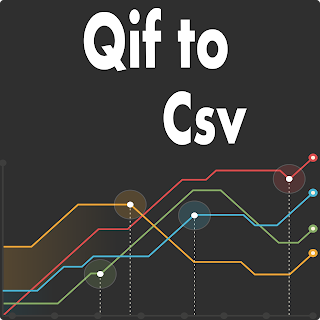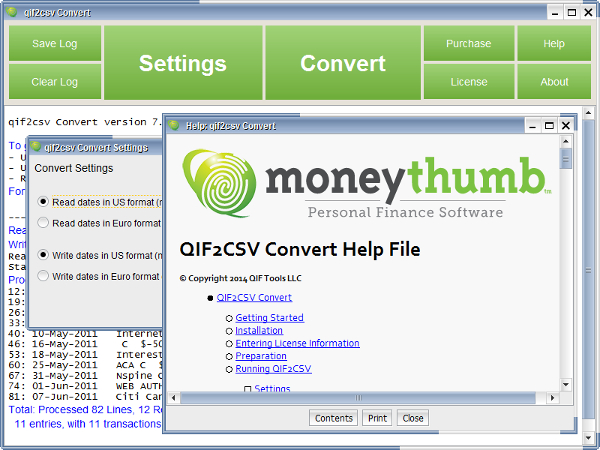This tutorial shows how to convert a CSV file from your bank or credit card statement to QIF and import into Quicken 2019. We will use the CSV2QIF utility. IMPORTANT: CSV2QIF is now replaced with the Transactions app, which converts from more formats and converts to more formats.
Step by step instructions for Windows

Follow the steps below for the Windows version, followed by the Mac version.
See a step-by-step tutorial at tutorial shows how to convert a transaction file to QIF format. We will use Bank. Sep 22, 2021 Convert CSV to QIF and import into Quicken PC 2005-2019, Quicken 2007 Mac, LessAccounting, YNAB, NetSuite, MYOB, AceMoney. Extract transaction data from CSV or Excel files from your bank. Prepare transactions quickly in Excel and convert. Work directly in Excel and copy data into the converter and convert. Open files in XLS and XLSX or CSV. See a step-by-step tutorial at tutorial shows how to convert a CSV file from your bank or credit card statement.
Make sure you are using the latest version of CSV2QIF. Download it from the CSV2QIF download page. Start CSV2QIF and select the CSV or Excel file.
You may also copy your data from an open spreadsheet like Excel and paste it inside the application.
Review transactions before converting. Check that dates are correct, have the correct year (Date), amount, withdrawals, and deposits are shown in corresponding columns, check number (Doc/Check#) is assigned. Reassign columns to QIF fields if needed.
Expenses must be negative and payments to the account must be positive. Your credit card file may have expenses positive. Adjust CSV Mapping if needed. Click 'Charges/Withdrawals' are positive if expenses are positive on the CSV file.
Duplicates are not considered during QIF import. Quicken for Mac 2015-2021 does not import QIF files. Quicken Essentials for Mac does not import QIF files. Converters to convert to the QIF format. The Transactions app. Convert CSV/Excel/TXT, PDF, OFX, QFX, QBO, QIF, MT940 files to the QIF format: Bank2QIF. Convert CSV/Excel/TXT files to the QIF.

Select the QIF Target to match your Quicken version or your accounting software: Quicken 2018+, Quicken 2017, Quicken 2015-2016, Quicken 2014 or earlier, Banktivity, Microsoft Money, NetSuite, MYOB, Reckon, YNAB, Quicken UK, AccountEdge, old Microsoft Money non-US, Quicken 4, Quicken French 2015.
Set the Account Name and the Account Type to create a QIF file for the right account, set the Date format if applicable.
Click the 'Convert' button to create a QIF file.
Confirm the file name and location.

Import created QIF file into Quicken 2019
Now the QIF file is created, let's switch to Quicken and import created QIF file. Before importing a QIF file make sure to backup your data. To import a QIF file, select 'File' - 'File Import' - 'QIF File', select created QIF file.
For Quicken 2017 or earlier, it is important to select 'All Accounts'. For Quicken 2018 or later you have to select the actual account.
Then click the 'Import' button.
Then click the 'Done' button.
Now your data is imported. Review transactions after import.
Step by step instructions for macOS
Make sure you are using the latest version of CSV2QIF. Download it from the CSV2QIF download page. Start CSV2QIF and select the CSV or Excel file. IMPORTANT: CSV2QIF is now replaced with the Transactions app, which converts from more formats and converts to more formats.
Review transactions before converting. Check that dates are correct, have the correct year (Date), amount, withdrawals, and deposits are shown in corresponding columns, check number (Doc/Check#) is assigned. Reassign columns to QIF fields if needed.
Expenses must be negative and payments to the account must be positive. Your Credit Card file may have expenses positive. Adjust CSV Mapping if needed. Click the 'Change amount sign' button once per file if expenses are positive on the CSV file.
Make sure to set the Account Name and the Account Type to create a QIF file for the right account.

Convert Csv To Qif Mac Free Download
Select the QIF Target to match your Quicken version or your accounting software: Quicken 2018+, Quicken 2017, Quicken 2015-2016, Quicken 2014 or earlier, Banktivity, Microsoft Money, NetSuite, MYOB, Reckon, YNAB, Quicken 2007 for Mac, Quicken UK, AccountEdge.
Set the Date format if applicable.
Click the 'Convert' button to create a QIF file.
Confirm the file name and location.
Import created QIF file into Banktivity
Now the QIF file is created, let's switch to Banktivity and import created QIF file. Before importing a QIF file make sure to backup your data. To import a QIF file, select 'File' - 'Import transactions'. Then click 'Import File' and select created QIF file.
Convert Csv To Qif Freeware
Select a Quicken account to import.
Then click the 'Continue' button.
Now your data is imported. Review transactions after import.